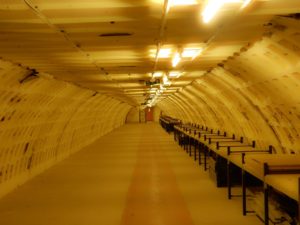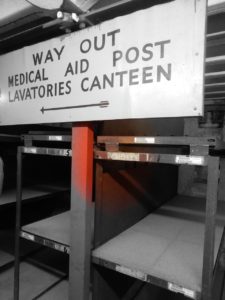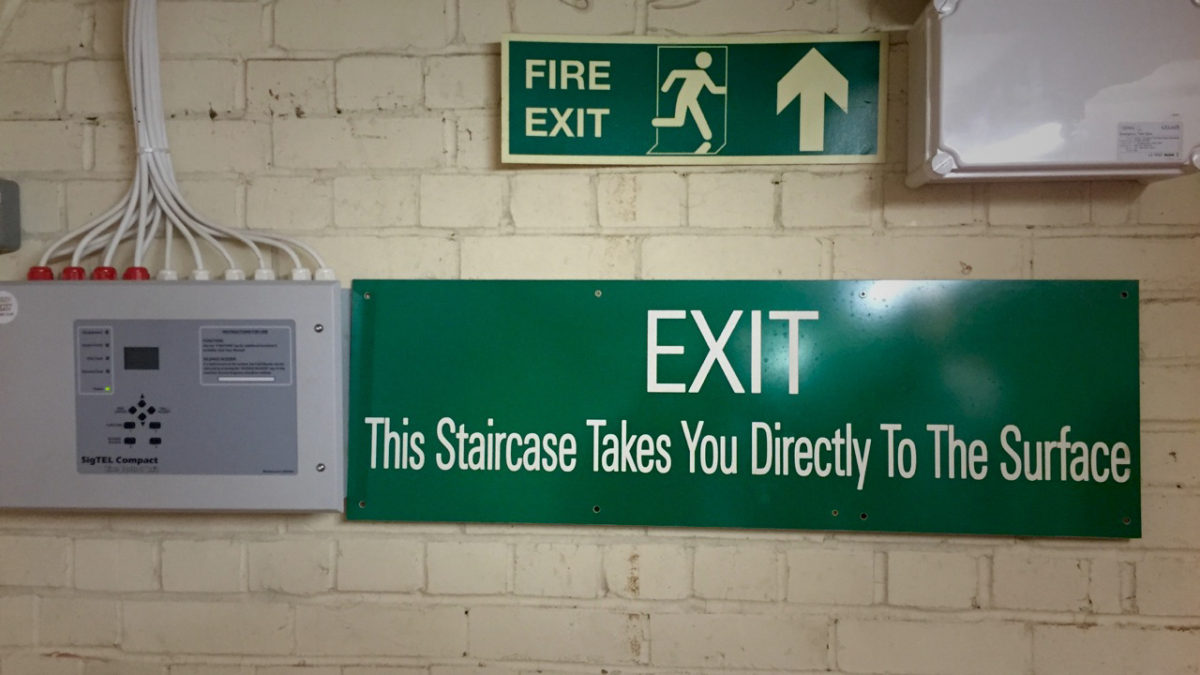Each morning as I walk across the Thames, I look to my left and see the sights of St Paul’s Cathedral, the gherkin and Canary Wharf. It’s an amazing – almost iconic – skyline. Although radically changed with the modern skyscrapers, can you imagine what it must have been like just over 70 years ago when a hundred or more doodlebugs, or the V-1 flying bombs as they were more officially known, could be filling the sky and you didn’t know what their target was.1
Early in the second world war, London had been bombed by the German Luftwaffe – a period known as The Blitz. In spite of early attempts by the government to lock them, Londoners took shelter in many of the city’s Underground stations. In addition, parts of the Underground were used to store national treasures. Today it’s on an unused branch line, but in the 1940s Aldwych tube station, that I visited once before, protected artefacts from the British Museum from the damage aerial bombing could inflict.
At the height of the bombing, there were demands from the public for the government to provide more shelters. The government turned to the London transport authorities – who had the technical experience building below ground – to build new shelters. And, even though the bombing raids over London had subsided, a total of 8 deep-level shelters we’re built (although 10 had been commissioned). All the new deep shelters were built near existing tube stations: the unrealised dream being to bring them into service as railways post-war.
The shelters were eventually used for their intended purpose in the latter years of the war when, in June 1944, the flying bombs were sent to attack the city.
Last Sunday, as part of London Transport Museum’s Hidden London series,2 I visited the deep-level shelter at Clapham South. The above-ground pillar box can still be seen just around the corner from the existing tube entrance. The shelter is connected to the station but the walls have long-since been sealed forcing visitors to descend (and return later) via a 180-step spiral staircase. The lift, it appears, either not in working order or no longer fit for public use. It’s not easy on the knees but, somehow, not quite as many steps as it sounds.
 Below ground is a fascinating place. Wartime pictures of the shelter show the kind of Blitz-spirited Londoners that only seem to appear on old newsreel films.3 In reality, the space built for almost 8,000 people, must have been cramped, crowded, smelly and – probably – very loud. Even with the welcome addition of the canteen-served jam tarts that were not subject to the ration book, I can’t imagine it was the nicest of places. Admittedly, the feeling of 120 feet of earth above you probably went a long way to making it a sanctuary from the horrors above the ground.
Below ground is a fascinating place. Wartime pictures of the shelter show the kind of Blitz-spirited Londoners that only seem to appear on old newsreel films.3 In reality, the space built for almost 8,000 people, must have been cramped, crowded, smelly and – probably – very loud. Even with the welcome addition of the canteen-served jam tarts that were not subject to the ration book, I can’t imagine it was the nicest of places. Admittedly, the feeling of 120 feet of earth above you probably went a long way to making it a sanctuary from the horrors above the ground.
 The tunnels through which you are escorted on the tour are astonishingly clean & tidy – having been most recently used as a secure archive storage facility – but it’s clear from the remaining bunk beds that life would have been cramped. Row, upon row, of the stacked bunk beds could have given almost 8,000 people safety in the Clapham South shelter; your particular bunk marked on the ticket required to access the shelter. Most people would have to bring their belongings down in to the shelter each time they went; exceptions were made for people whose houses had been destroyed by the war. That’s 180 steps with mattresses and other personal items that you wanted to keep with you.
The tunnels through which you are escorted on the tour are astonishingly clean & tidy – having been most recently used as a secure archive storage facility – but it’s clear from the remaining bunk beds that life would have been cramped. Row, upon row, of the stacked bunk beds could have given almost 8,000 people safety in the Clapham South shelter; your particular bunk marked on the ticket required to access the shelter. Most people would have to bring their belongings down in to the shelter each time they went; exceptions were made for people whose houses had been destroyed by the war. That’s 180 steps with mattresses and other personal items that you wanted to keep with you.
Post-war, the shelters have been used as a hostel for visitors to the great exhibitions of the Festival of Britain in 1951, places for incoming migrants to stay until they found permanent accommodation or as army barracks. In later years, the Clapham South shelters were the aforementioned storage facility while a nearby tunnel, that you don’t visit, is today used to grow salads under LED lighting.4
Walking across the Thames bridges in the August sunshine is a world away from the realities of wartime in the city: the Hidden London deep-level shelter tour a small, but important, reminder of what people went through and a fascinating insight into the ingenuity of the city to protect citizens in more difficult times.
Hidden London
If you’re interested in the Hidden London series of tours, visit the London Transport Museum site to see when the next series is scheduled.
About BEWA 2016
BEWA (Blog Every Wednesday in August) is a project aimed to get me writing in a blog style again. I wrote an introduction to kick the series off while the first proper entry championed an Olympic legacy. The third discussed my fascination with location data while what should have been the fourth entry was more of an Oops. There is a page with the #bewa collection (including those from last year). Fingers crossed I am back next week. I’m sure @curns will mention it.
Footnotes
1 V-1 flying bomb, Wikipedia
2 Hidden London, London Transport Museum
3 Clapham South Deep Level Air-Raid Shelter, Subterranea Britannica
4 Growing Underground: A Visit To Clapham’s Deep Level Farm, Londonist

After I missed week, earlier today, #bewa returned with a visit to the Clapham South Deep Level Shelter: https://t.co/wTbC8A7EWo